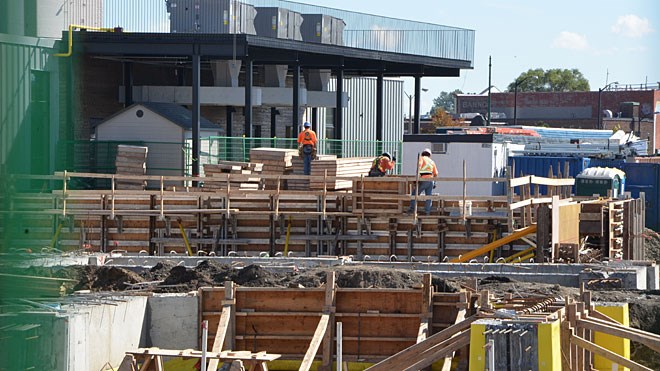Wood frame buildings over four storeys tall will become a possibility in Ontario in the new year.
On Jan. 1, 2015, the province's building code will be amended to allow wood frame buildings up to six storeys in height. Wood buildings were previously limited to four storeys in Ontario.
"It's a very positive move forward for not only wood construction, but construction itself," said Steven Street, technical director of WoodWORKS! Ontario, a Canadian Wood Council campaign meant to increase the use of wood in commercial, industrial and institutional construction in North America.
Street said the biggest advantage wood has over steel and concrete, as a building material, is that it can lower the cost of a project by up to 20 per cent.
Street campaigned to allow for taller wood buildings in Ontario for more than four years.
"It took a significant amount of time for people to understand what kind of a system we had with some of our newer technologies," he said.
Most European Union countries allow wood frame buildings up to six storeys.
In Norway, one architectural firm plans to build a 14-storey timber building.
In British Columbia, more than 50 wood-frame buildings have been built since its building code was changed in 2009 to allow for wood construction projects up to six storeys in height.
Quebec was the next province to allow wood-frame buildings up to six storeys high in 2013.
Street said new technologies have made taller wood-frame buildings more viable, and have addressed many of the safety concerns linked to wood construction.
Opponents to taller wood-frame buildings have long cited the increased risk of fires as the strongest reason not to go beyond four storeys.
But advances in technology have allowed for more fire-resistant wood materials and better performing sprinkler systems, said Street.
David Warne, a partner with Toronto-based LGA Architectural Partners, helped design the second phase of the Laurentian University School of Architecture.
The two-storey wood-frame addition to the school, which will feature the library wing, uses a material called cross-laminated timber.
The product is built in a modern plant that glues together pieces of plywood and compresses them, to create dense wood frames.
Warne said the thickest frames are as fire-resistant as steel, and can take up to three hours to burn.
"Once the wood is all in place it's very fire-resistant," he said. "It's during construction that it's more vulnerable."
To protect wood structures during the more vulnerable construction phase, some have suggested installing the sprinkler system early in the building process, instead of waiting until the very end.
Laurentian had to purchase its cross-laminated timber from Quebec, because the product is not yet manufactured in Ontario.
"We could easily have a plant in Ontario and be using our own wood," Warne said.
Once six-storey wood-frame buildings start to pop up around the province, he said it will make the production of cross-laminated timber more viable in Ontario.
Terrance Galvin, director of Laurentian's School of Architecture, said the new wood addition to the school, currently under construction, was limited to two storeys because it is for a public building.
"If we were starting that process today, we might have discussed making it three storeys, like the building on Elm Street," Galvin said.
He said he supports the province's decision to amend the building code because it will promote more wood construction in Canada.
"What's great about wood, in terms of sustainability, is that wood grows back," Galvin said. "It really is the only truly organic and renewable resources."
He added that for him, wood also offers a warmer and nicer material than concrete, in terms of ambiance.
The school of architecture already has courses on wood structures and the change to the building code will open up more possibilities for his students, Galvin said.
Laura Higgs, executive officer with the Sudbury and District Home Builders' Association, said allowing for taller wood structures helps address many of the concerns builders have faced with rising construction costs.
The new rules will also address the push for more intensification in most cities' official plans.
While six-storey wood structures are not likely to be as popular in Sudbury as they would be in more dense urban centres, such as Toronto and Ottawa, Higgs said she expects some of her organization's members to try their hands at taller wood frame buildings.
"I don't think it will be a big trend, but I think you'll see a few," she said.
Join Sudbury.com+
- Messages
- Post a Listing
- Your Listings
- Your Profile
- Your Subscriptions
- Your Likes
- Your Business
- Support Local News
- Payment History
Sudbury.com+ members
Already a +member?
Not a +member?
Sign up for a Sudbury.com+ account for instant access to upcoming contests, local offers, auctions and so much more.
